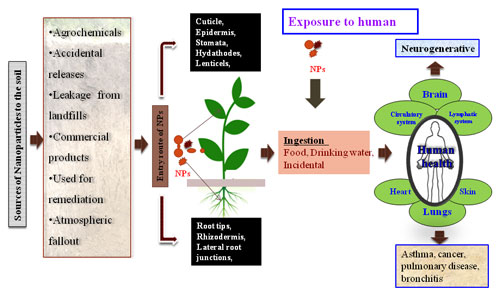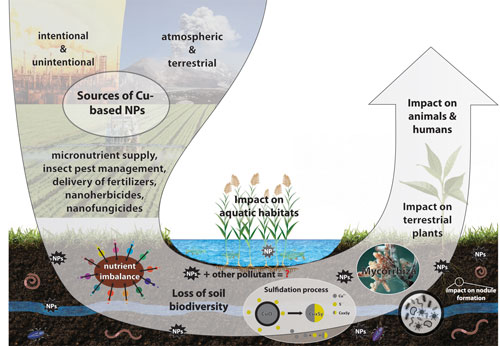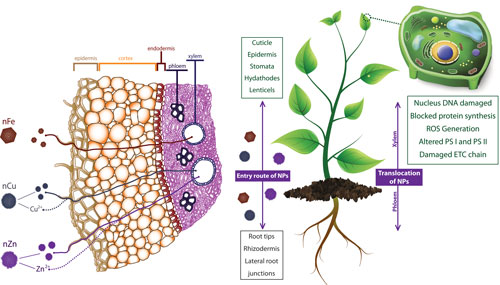| Oct 21, 2019 | |
Environmental challenges and future perspectives of metal-oxide nanoparticles |
|
| (Nanowerk Spotlight) The increase in production and applications of metal-oxide nanoparticles (MO-NPs) raises concerns for the environment as well as for human health. The terrestrial environment, especially soil, is expected to be the largest repository for environmentally released MO-NPs. Therefore, the accurate determination of environmentally released MO-NPs is imperative to assess the real-time scenario of toxicity to soil biota and the threat to human beings via the food chain. | |
| Thousands of nano-products including nano-fertilizer and -pesticides are available in the market, and many of them do not mention the used concentration and types of nanoparticles. Thus, a series of safety evaluation and toxicological risk assessment standards must be formulated before unlimited applications of MO-NPs become commercially available. | |
 |
|
| Overview of soil contamination and impacts on human health. (Reprinted with permission by Springer Nature) (click on image to enlarge) | |
| The commercial production of metal-oxide nanoparticles is estimated to reach more than 1.6 million tons by 20201. There are more than 1600 nanotechnology-based consumer products, and an online database lists more than 3000 products in various categories that contain nanoparticles.2 More than 60% of these products didn't disclose their identity of the used nanoparticles.2 Many more nanoparticle-containing products could appear in the coming years with new characteristics and novel applications. Due to the benefits derived from their specific characteristics, physical and chemical properties, and high surface-volume ratio, the application of metal-oxide nanoparticles in the industry is increasing rapidly. | |
| Applications for these MO-NPs include consumer products, agriculture, coatings, cosmetics, chemicals, electronics and optics, environmental remediation, food packing, fuel additives, energy, textile and paints, next-generation medicine and plastics. | |
| However, as the commercial use of MO-NPs rises, the amount of them ending up in the soil – either directly dumped or via landfills from discarded product, sludge and other wastes – increases as well.3 This raises a range of potential issues regarding ecological, ethical, health & safety, policy and regulatory aspects. | |
| MO-NPs ending up in the soil could affect its physical and chemical properties, interact with other pollutants, and form new kinds of toxic compounds. Since MO-NPs could remain in the soil for an extended time, there is a risk that they disturb the soil's microbial functionality, plant growth, and consequently human health via the food chain. | |
| However, until today, reliable methods to detect, identify and quantify MO-NPs in the presence of natural nanoparticles are missing. Knowledge regarding the behavior and potential toxicological risks of MO-NPs in soils is emerging – albeit with major gaps. | |
| Several research studies and reviews suggest that among MO-NPs, CuO and ZnO nanoparticles are toxic to a wide range of organisms, especially for plants and human beings.4,5 Scientists assume that CuO and ZnO nanoparticles can cause toxicity either by releasing ionic forms or by direct interactions with plant tissues.6 | |
 |
|
| Schematic of CuO NPs sources to environment and their effects on different ecosystems. (Reprinted with permission by Springer Nature) (click on image to enlarge) | |
| The mechanism of MO-NPs uptake and toxicity are not well established yet. Therefore, it is essential to explore in-depth and in a systematic way the mechanism of nanoparticles' toxicity, accumulation in plant tissues, interactive forms and their bio/geo-transformation. | |
| Complicating matters is the fact that the fate of MO-NPs may vary with the varying physiology/anatomy of plant/organism species, and types of medium. | |
| To date, most of the studies on interactions of MO-NPs and plants have been performed on agar or in hydroponic media or in controlled conditions, which do not reflect the actual interaction in realistic environments such as soil ecosystems. | |
| In our opinion, the quantitative estimation of MO-NPs in the edible parts of food crops must be measured carefully before supplying these products to consumers. It is also crucial to develop a unified methodology for testing nanoparticles' toxicity in natural environments. | |
| With the help of this methodology, joint research should be conducted to determine the toxicity of MO-NPs under different climatic conditions and soil types to develop the permissible levels for applications and determine the threshold levels of their contents in respective soils. | |
 |
|
| Schematic presentations of nanoparticles uptake, translocation and phytotoxicity. (Reprinted with permission by Nova Science Publishers, Inc.) (click on image to enlarge) | |
| Another way to reduce the release of MO-NPs into the environment is to match their quantities with the stage of crop growth with the most significant response. For example, the appropriate application of small amounts of nanoparticles had maximum benefits to crops when applied to the seeds in a pre-germinative manner. | |
| Sustainable use of MO-NPs could help to utilise the beneficial effects of their application – i.e. in the form of nanopesticides – without posing a threat to living organisms. | |
| We therefore suggest that a series of safety evaluation and toxicological risk assessment standards must be formulated for MO-NPs applications that include exposure route, safe exposure doses, the kinetics of dissolution and migration to the groundwater. | |
| Future research must be conducted in the context of current risk assessments associated with MO-NPs, their use, distribution, and release in the environment. | |
| Conflict of interest: Authors declare that they have no conflict of interest. | |
References |
|
| 1. The Global Market for Metal Oxide Nanoparticles to 2020. Research and Markets, 2013. | |
| 2. The Nanodatabase; DTU Environment, the Danish Ecological Council and Danish Consumer Council | |
| 3. "Emerging patterns for engineered nanomaterials in the environment: A review of fate and toxicity studies"; Journal of Nanoparticle Research | |
| 4. "Interaction of Copper-Based Nanoparticles to Soil, Terrestrial, and Aquatic Systems: Critical Review of the State of the Science and Future Perspectives"; Reviews of Environmental Contamination and Toxicology | |
| 5. "Effects of zinc-oxide nanoparticles on soil, plants, animals and soil organisms: A review"; Environmental Nanotechnology, Monitoring & Management | |
| 6. "Toxicity of copper oxide nanoparticles on spring barley (Hordeum sativum distichum)"; Science of The Total Environment | |
|
By Dr. Vishnu D. Rajput ([email protected]) and Prof. Tatiana Minkina, Southern Federal University, Rostov-on-Don, Russia
|
|
|
Become a Spotlight guest author! Join our large and growing group of guest contributors. Have you just published a scientific paper or have other exciting developments to share with the nanotechnology community? Here is how to publish on nanowerk.com. |
|
